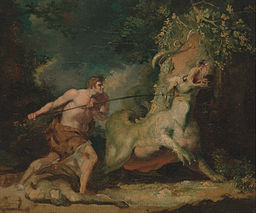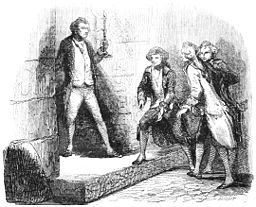Tags
18th Century, blackpowder, Consulate Era, Eighteenth Century, First Empire, French Directory, French Revolution, Georgian, Ghastly Affair, gothic game, Gothic Gaming, Gothic Horror, Gothic Literature, Gothic Romance, Gothick, Gothique, Historical, Historical Gaming, History, Louis Seize, Louis XV, Louis XVI, Napoleonic, nineteenth century, OGL, Regency, role playing, role-playing game, roleplaying game, Romantic Age, Romantic Horror, Romantic-era, Romanticism, rpg, schauerroman
The historical sources for Ghastly Affair’s Demon Hunter class range from the vampire-hunting dhampirs and vampirovici of the Balkans, to the witch-hunters that terrorized 17th century Europe and America. Oddly, the hunter of supernatural horrors seems not to have become an established literary trope until the 19th century. The earlier Gothics were thick with agents of the Inquisition, but those characters were always more interested in torturing innocent people than pursuing the actual forces of evil. In Sheridan Le Fanu’s story collection “In a Glass Darkly” (which includes both “Green Tea” and “Carmilla”) we find two scholars and adversaries of the supernatural – Doctor Hesselius, and Baron Vordenburg. Those characters were perhaps the inspirations for Bram Stoker’s iconic Doctor Abraham Van Helsing, easily the best-known and most-influential example of the Demon Hunter. Nowadays, the figure is such an expected part of horror novels, movies, and television shows that is easy to forget that it does not have especially deep roots in literary horror prior to the late 19th century. Nonetheless, it can be one of the most enjoyable archetypes to explore in the context of a role-playing game. With that in mind, here are some people, characters, songs, and images to help inspire the creation of your own Demon Hunter characters.
Some Historical Demon Hunters:
Matthew Hopkins
Karl Ferdinand Von Schertz [Author of “Magia Posthuma”]
Jean Chastel
Johann Heinrich Zopf (or Zopfius) [Author of “Dissertatio de Vampyris Serviensibus”]
Dom Augustin Calmet
Johann Joseph Gassner
Johann Flückinger [Austrian army surgeon who exhumed suspected vampires during the 1731 – 1732 hysteria in Serbia]
Cotton Mather
Some Literary Demon Hunters:
Thomas Carnacki (Carnacki, the Ghost Finder – William Hope Hodgson) [Multi Classed Demon Hunter / Magician]
Harry D’Amour (The Last Illusion, Everville, more. – Clive Barker)
Lila Davenport (Hunter’s Song – William Rutter)
Parl Dro (Kill the Dead – Tanith Lee)
Jonathan Harker (Dracula – Bram Stoker)
Dr. Martin Hesselius (In a Glass Darkly – Sheridan Le Fanu)
Solomon Kane (Red Shadows, etc. – Robert E. Howard)
Ann Radcliffe(!) (Vampire City – Paul Féval)
John Silence (John Silence, Physician Extraordinary – Algernon Blackwood) [Multi Classed Demon Hunter / Magician]
Doctor Abraham Van Helsing (Dracula – Bram Stoker)
Baron Vordenburg (Carmilla – Sheridan Le Fanu)
Special mention to Mina Harker. Although never explicitly stated in the text, the ending of “Dracula” can be read as implying that Mina and Jonathan Harker go on to further study and oppose the vampires of Transylvania.
I have included some examples of the “Occult Detective” variety, for those who prefer to run their Demon Hunters more as demonologists and investigators than slayers. Such characters could be allowed to make their Obsession be oriented towards solving supernatural mysteries, rather than always destroying monsters.
Some Demon Hunters from Movies and Television:
Elizabeth Bennet (Pride and Prejudice and Zombies)
Nick Burkhardt (Grimm)
Clementine Chasseur (Hemlock Grove)
Ichabod Crane (Sleepy Hollow – TV Series)
Grégoire de Fronsac (Brotherhood of the Wolf)
Charles Gunn (Angel – TV Series)
Catriona Hartdegen (Penny Dreadful)
Carl Kolchak (Kolchak: the Night Stalker)
Captain Kronos (Captain Kronos – Vampire Hunter)
Faith Lehane (Buffy the Vampire Slayer)
Jack Marshak (Friday the 13th: The Series)
Sir Malcolm Murray (Penny Dreadful)
Buffy Summers (Buffy the Vampire Slayer)
Professor Timothy Eliot Stokes (Dark Shadows, House of Dark Shadows [Movie])
Peter Vincent (Fright Night)
Ash Williams (The Evil Dead)
Sam and Dean Winchester (Supernatural)
A Few Inspirational Songs:
Defender – Manowar
Evil – 45 Grave
Fight– The Cure
Flash of the Blade – Iron Maiden
God’s Gonna Cut You Down – Traditional. Versions by Johnny Cash, others.
No Quarter – Led Zeppelin
Screaming For Vengeance – Judas Priest
Wrathchild – Iron Maiden
Vampire Hysteria in the Eighteenth Century
Prior to the eighteenth century, vampires as such were largely unknown to Western Europe. There were certainly vampire-like beings thought to exist in various places, such as the lamia of classical legend, or the dearg dul of Ireland. However, the word “vampire” (from the Serbian vampir) didn’t enter into the mass consciousness of the West until several incidents in early 1700s Eastern Europe (the most famous of which were the cases of Arnold Paole and Petar Blagojevich). The panic spread across the lands controlled by the Austrian Habsburgs, in places (such as Serbia and Transylvania) where vampire hunting and destruction were long established practices. By the 1730s, the so-called “Vampire Controversy” was ignited in Western Europe by newspaper reports of recent vampire attacks in Serbia (and the subsequent openings of graves to destroy the supposed revenants). French, German, and English authors began discussing vampires in medical treatises, theological texts, and travel journals. Voltaire himself weighed in, stating that the only real vampires were involved in business, tax collection, and finance. By the 1740s, the vampire had become established as an object of fear in Western European countries where it had never before existed in folklore. It wasn’t until the publication of “The Vampyre: A Tale” in 1819, however, that the modern Western image of the vampire as a dapper aristocrat emerged.
Credit for Image 3 : Wellcome Library, London. Wellcome Images images@wellcome.ac.uk http://wellcomeimages.org . Copyrighted works available under Creative Commons Attribution only licence CC BY 4.0 http://creativecommons.org/licenses/by/4.0/





“In a Glass Darkly” (which includes both “Green Tea” and “Carmilla”) we find two scholars and adversaries of the supernatural – Doctor Hesselius, and Baron Vordenburg.
And Hesselius, while not evil, was largely ineffectual.
You mention Penny Dreadful among your inspirations. How would you characterise Vanessa Ives? She takes in Magician, certainly, but there’s a bit of Demon Hunter to her if for no other reason than it’s how she keeps from being a demon. And if there’s anyone in the world who could somehow manage to be both a Libertine *and* a True Innocent…
*Minor Spoilers For Penny Dreadful Follow*
Vanessa is a complicated and interesting character that’s hard to pin down. If I was to make a PC (or NPC) inspired by her, I would probably use Magician as the base class, but have her also be a Demoniac. Vanessa struggles with her possessing entity throughout the series. She would have an exceptional Charisma and the Asset “Strong Personality”, representing how she is usually able to suppress the Demon (although she also succumbs frequently). I would use the Affliction “Desired by Evil” to represent how she can’t escape the attention of the dark powers. Alternately, the character could be portrayed not as an actual Magician, but instead an Everywoman with “Occultist” as her Profession (or Avocation).
I also see a bit of the Demon Hunter in Mina Harker even before the end of DRACULA because she’s the one who collects and organizes all the research, letters etc. about Dracula from which the heroes learn of his plans. So while she may not be a slayer-type hunter she could perhaps be thought of as an investigator as you’ve described.
As you say, a special mention.
She’s also the one who comes up with the idea of hypnosis to reverse her link to Dracula and track him, so she’s inventive too.